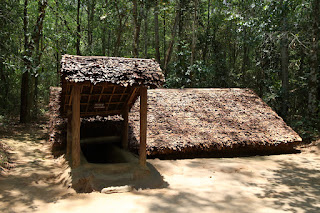After two weeks in Saigon*, and our time mostly having been preoccupied with work and finding an apartment, we finally had some time to feel like tourists. The 30th of April is Reunification / Liberation Day in Vietnam. It is a national holiday to mark the end of the Vietnam War (or American War as it is known in Vietnam) which officially ended on 30 April 1975 when Viet Cong and North Vietnamese troops captured Saigon. The war had started in November 1955 and had lasted almost 20 years. The Cu Chi tunnels had played an important role during the conflict as they provided an underground network for the Viet Cong to hide in.
The total length of the Cu Chi tunnels is apparently over 200 km. It included tunnels that were close to the surface and which were used mainly during combat. It also included deeper tunnels, that were less likely to be destroyed by bombs, that were used as short-term living spaces, storage spaces, hospitals, etc.
Seeing as 30 April is Reunification / Liberation Day, it also seemed like a good day to visit the tunnels.
One of the American tanks that was destroyed during the war is on show at the tunnels
Our guide, Ken, explaining how the Viet Cong had set traps throughout the area (above)
and various types of traps on display (below)
and various types of traps on display (below)
The holes that were used to access the tunnel system were extremely small, and once the cover was put in place it was almost impossible to find the tunnel access routes. Apparently the Viet Cong did not draw maps of the area or the access points, but rather relied on memory.
As small as the hole was that we climbed into, this was in fact not the actual size of the tunnel access holes. This hole had been increased in size to accommodate European tourists. The photo below shows the actual size of the holes that were used to access the tunnels.
Below: This hole is used to show how small some of the tunnels were. The tunnels, which lead off from the bottom of this hole, are so small that you could only get through them on your stomach. Oh, and watch out for the bats which have since made these tunnels home.
It was then time to access one of the tunnels. The tunnels are now clearly marked and protected from the rain, but this wouldn't have been the case during the war. Once again, the tunnel that we accessed had been increased in size to accommodate tourists. Instead of 1m high and 1m wide, these tunnels had been increased in size so that they were now 1.4m high.
The photo above shows one of the craters that was left behind by a B52 bomb. Although this area was heavily bombed, there are not as many craters as one might expect to find. Apparently the earth that was excavated, by hand, to create the tunnels was then used to fill the craters. This made it less obvious where the tunnels had been built as there were no mounds of soil left lying around.
And finally, emerging from the ground :)
* Although officially called Ho Chi Minh City, almost everybody here still refers to it as Saigon.


















No comments:
Post a Comment